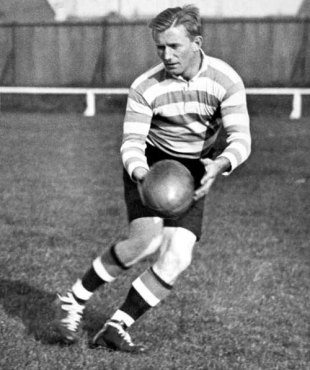|
1928
Springboks consign the 'rover' to history
Huw Richards
July 31, 2009

Springbok Bennie Osler tormented New Zealand in 1928
© Getty Images
Enlarge
As the All Blacks go seeking rapid revenge against the Springboks this weekend they could hardly hope for a more propitious venue than Durban, where they have won three times in their last four visits. It wasn't always like that, though. Their first visit, for the first ever Boks-Blacks Test on South African soil in 1928, was not so happy and had long-term consequences. It was not a happy tour. The New Zealand Rugby Union, following the shameful precedent set by the Forces team of 1919 and applied until 1960, had left their non-white players at home. In 1928 these included the incomparable George Nepia. Brilliant five-eighth and vice-captain Marcus Nicholls fell out with skipper Maurice Brownlie. Neither was remotely an easy man, and their differences of personality and philosophy did little for team-spirit or performance - Nicholls was excluded from the first three Tests. And like their successors of 1949 they were both tired and enraged by excessively long train journeys apparently scheduled for the maximum inconvenience. The greatest problem of the lot, though, was on the field - in the scrummages. New Zealand's cherished seven-man 2-3-2 scrum formation had more than held its own against British teams in 1905 because its players specialised in their positions and the inward pressure exerted by the two props on the opposing hooker more than compensated for the weight of eight opponents driving straight ahead. By 1924 it was becoming more of a problem with British forward technique, particularly England under the influence of Wavell Wakefield, becoming more sophisticated. But New Zealanders continued to argue that the extra attacking opportunities provided by the hybrid 'rover' as eighth man outweighed any losses in the scrum - and had the 'Invincibles' tour record to buttress their case. It was in 1928, though, that nemesis struck in the form of the South African 3-4-1 scrummage. By driving inwards rather than straight ahead, the South Africans put the two-man New Zealand front row under intolerable pressures. New Zealand's problems began in the second match, when Western Province took 30 of the 46 scrums and won the match 7-3 and grew from there, redoubled by the rules of the time which allowed a team to opt for a scrum instead of a line-out. While the All Blacks were exploring the local rail system, the Boks were holding a week of intensive trials in Durban. Sixty players were summoned with a clear message that, amateurs or not, those who did not attend would not be selected. Wearing, for no obvious reasons, black shorts, the Boks took complete charge in the Test match, played on the Kingsmead cricket ground. They were reduced to 14 men when centre Brooke Duffy was injured only five minutes into his sole international, but still their seven forwards prevailed. Nicholls was to record: "They heeled from fully 95 per cent of the loose scrums…they pushed our pack all over the field, they got possession from the set scrums at will and, during one period in the second half, they heeled from 16 scrums in possession." F.M. Howard reported in The Times: "Other packs have managed before now to subdue a representative All Black pack, but never before have I seen or heard of one that maintained its grip without a break and never relaxed for even five minutes out of the 80". In the second half New Zealand were 'simply annihilated. There is no other word adequately to describe the overwhelming of the All Blacks'. Howard reckoned that fourth-fifths of the second half was played in the All Black half. And South Africa had the perfect man to make the most of territorial advantage. Bennie Osler would come to personify an era of grinding South African dominance, an ultra-conservative kicking half-back building on the power of his forwards. Osler landed drop goals either side of half-time - then worth four points each - and added two penalties as the pressure told on the All Blacks. Wing John Slater rounded off a 17-0 victory that stood until 1999 as New Zealand's largest margin of defeat. Remarkably the All Blacks hit back to share the series after, in an echo of Wales copying the 'rover' to beat them in 1905, adopting a three-man front-row in the remaining matches and recalling Nicholls, who had perhaps the best single afternoon of a magnificent career, for the last. New Zealand reverted to 2-3-2 against Australia in 1929, and lost all three tests. The old formation had its final fling against the 1930 Lions, but All Black victories were accompanied by the blunderbuss diplomacy of Lions manager Bim Baxter who condemned the rover outright as a 'cheat'. A ruling by the IRB - of which Baxter was perhaps the most influential member - in 1932 made the two-man front-row impractical by insisting that the ball must go past at least three front-row feet before it could be hooked. At one level this was an imperial proscription of one of New Zealand's most cherished traditions. In practice, though, the two-man front row was doomed from that afternoon in Durban in 1928. As Graeme Barrow wrote in his highly entertaining short history Up Front:The Story of the All Black Scrum: "Their 2-3-2 scrum could never again be used with impunity. It had met a superior and more powerful formation, and had been unable to survive against it without modification". © Scrum.com
|
Live Sports
Communication error please reload the page.
-
Football
-
Cricket
-
Rugby
-
- Days
- Hrs
- Mins
- Secs
F1 - Abu Dhabi GP
Abu Dhabi Grand Prix December 11-131. Max Verstappen ()
2. Valtteri Bottas (Mercedes)
3. Lewis Hamilton (Mercedes)
4. Alexander Albon ()
5. Lando Norris ()
6. Carlos Sainz Jr ()
-
ESPNOtherLive >>
Golf - Houston Open
Snooker - China Open
Tennis - Miami Open

